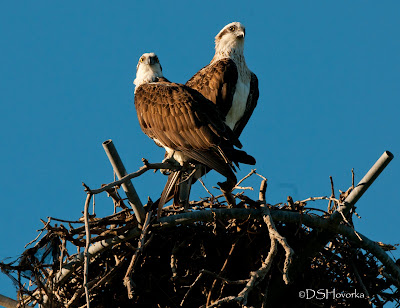 |
Red-rumped Parrots
|
Even though it was a rainy day, we drove along interior road between two different parts of Sundown, it was a great, birdy road. We saw a small flock of aptly-named red-rumped parrots from afar, and Dirk was determined to get a better picture. They are such beautiful birds! This burned out stump seemed of particular interest to this pair. When we decided to move away from it, the female disappeared inside, indicating they probably had a nest in there, somehow. We left the area so they could tend their young in peace.

Surprisingly, we saw this gorgeous Black-necked Stork (affectionately called a Jabiru) along one of the main roads on the Gold Coast (on our way driving to Sundown NP). In the "Green Heart" where they haven't developed yet, perhaps because it is a floodplain that regularly floods and for some reason, they haven't channelized it yet like every other wetland here. We could tell this bird is a female, because of her golden eye. The males have black eyes. They are big birds, with a wing span of two metres.
While eyeballing some red-rumped parrots grazing near the size of the road, this little gem popped into our vision--a plum-headed finch. They happened to also be on our to-see list, so we were glad to spot him! Glad he's getting some good grass seeds to eat.
These white-plumed honeyeaters were a curious bunch. No sooner had we pulled up and walked away from the 'Rav' (our new little 4WD), than these two, and one other companion, immediately flew over and started inspecting themselves in the sideview mirrors. They had a mission, and seemed to know exactly what they were doing, but we couldn't figure it out! They seemed to like the raindrops on the mirrors? They weren't fighting with the other 'strange' birds (their reflections), rather, they seemed almost to be grooming, and using the beads of water to wash up? Very curious!

Bright pink galahs gaily decorate the gray-green mistiness of a somber day. I was surprised, one day in the train station, to see a 2x3 ft poster featuring a close-up of a Galah's pretty face. The writing on the poster said simply 'Don't be a Galah.' Apparently it's used in commercials against drunk driving. As in, 'don't be a bloody galah!' (or fool). We like these birds, but apparently they have some sort of a bad reputation. They eat spilled grain and other things by the side of the road, and I imagine they get killed alot by people who don't bother to let them get out of the way. So, who's the fool?!
This nice kangaroo and her joey were relaxing near our campsite, but she kept a close watch on the little guy.
We were eating lunch when I saw something out of the corner of my eye moving around the tent. I decided to investigate, and much to our surprise, there was this 4ft long Goanna (we don't know exactly what it is), ambling across our campsite into the grasses at the edge. Good thing he had absolutely no interest in us, at all!
























